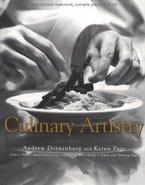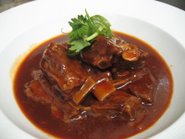Café Pralet is the latest extension by Creative Culinare, a well known pastry and bakery school that provides leisure hands on baking classes and consultancy. Managed by Chef Judy Koh, a professionally trained and well traveled pastry chef, the nine year veteran on Eng Hoon Street has just recently moved across to the new Eng Hoon Mansions.
Café Pralet is the showcase for Judy’s inspirations and creative talents in pastry arts and bakery. The café has two dinning concepts, a formal area to handle the more challenging dishes on the menu and a cozy sofa decked patio for coffee, tea, pastries and nibbles. Wireless services are provided for those who live by the net and there are books to read from poetry to culinary or just simply laze and watch the world go by in old Tiong Bahru.

We like the coziness of the sofa patio that shows the feminine touch of Judy as N puts it in terms of colours and the rustic wooden shelf that carries all the reading materials.
Going through the menu, we made many happy discoveries. The menu is kept simple but offers both Western and Asian favourites which mean I could bring mum here too. There are made to order sandwiches and salads with a choice of freshly baked breads or something heartier like chops, pasta and fish and chips. The small Asian selection includes curry, Ayam Tempra, Laksa and Mee Siam. There are also snack breads with different fillings and cookies as well as festive specialties according to each incoming festival. The must try pastries includes Pralet, Judy’s signature and other wonderful items like Blackforest, Lychee Martini which was unfortunately sold out on our second visit and a tempting Summer Strawberry cake. The pastries are rotated based on whatever inspires Judy from next door. Best of all, the prices of all food and beverages are very reasonable compare to town prices for a place like this where u can hang out.
 We started with fish and chips which immediately got our vote as the best for quality, portion and taste in café standards overtaking Secret Recipe and Swensens by the miles. Crusted with nice crispy buttery batter, the entire piece of white dory or Vietnamese catfish as it should be more correctly known, took up more than half of the space of the dinner plate and we had to manage it with an extra serving of tartare sauce and chili sauce. More importantly the food was serving piping hot, crucial for a dish that is deep fried and the chunky quality catfish free of any “
We started with fish and chips which immediately got our vote as the best for quality, portion and taste in café standards overtaking Secret Recipe and Swensens by the miles. Crusted with nice crispy buttery batter, the entire piece of white dory or Vietnamese catfish as it should be more correctly known, took up more than half of the space of the dinner plate and we had to manage it with an extra serving of tartare sauce and chili sauce. More importantly the food was serving piping hot, crucial for a dish that is deep fried and the chunky quality catfish free of any “ mud taste”. Given the serving that we enjoyed, it costs less than $10 per order! An unbelievable excellent value for money item on the menu.
mud taste”. Given the serving that we enjoyed, it costs less than $10 per order! An unbelievable excellent value for money item on the menu.N loved the low calorie inspired Laksa which she had on the second visit. To meet its claim, very little or I suspect none at all was coconut milk used in the preparation of the laksa yet it still manage to achieve the right level of richness despite not having the element of coconut milk flavour. The freshly chopped laksa leaves reinforce the dish’s character despite the absence of the other key element.

All this while, mum was enjoying her Mee Siam too. The sour assam flavoured gravy was embodied with a decent pungency of fermented soya beans and enriched with the right tinge of coconut milk, giving it a nice aroma. As it is always said, with good gravy, the garnishes and condiments will never be able to steal the thunder from it.
When it comes to their pastries, the most celebrated piece would be Judy’s signature’s Pralet. Chocoholics will love this ganache layered piece of indulgence elegantly topped with a small piece of gold leaf.
 The base is supported by a crispy wafer crust and the ganache tastes of quality bitter chocolate with a nice gentle sweetness. It is an excellent piece to go with coffee or tea.
The base is supported by a crispy wafer crust and the ganache tastes of quality bitter chocolate with a nice gentle sweetness. It is an excellent piece to go with coffee or tea. Still on the chocolate arena, the brownies are here are much lighter on the palate than being commonly oversweet, dense and fudgy. It is more like a combination of moist chocolate cake and fudge, specked with chunky pieces of walnuts in between. Best of all, the most ideal ice cream to top with this brownie is the home made rum and raisin flavour that will sent you on a “high” with its intense flavour impact of rum.
Still on the chocolate arena, the brownies are here are much lighter on the palate than being commonly oversweet, dense and fudgy. It is more like a combination of moist chocolate cake and fudge, specked with chunky pieces of walnuts in between. Best of all, the most ideal ice cream to top with this brownie is the home made rum and raisin flavour that will sent you on a “high” with its intense flavour impact of rum. One of my favourite sponge cakes is the Bavarian Kirschtorte or more commonly known as Black Forest Cake. Unfortunately many local chefs distort this wonderful recipe by using non dairy pastry whip, maraschino cherries, chocolate rice and an absence of any flavoured liquor. Hence to be able to experience Judy’s creation was like rediscovering a lost heritage so badly trashed. The whipped cream, the sour cherries, the liquer soaked chocolate sponge and the chocolate shavings, everything was there in the right proportions helped to restore my confidence again that it is still possible to find a decent black forest cake in a heartlands neighbourhood.
One of my favourite sponge cakes is the Bavarian Kirschtorte or more commonly known as Black Forest Cake. Unfortunately many local chefs distort this wonderful recipe by using non dairy pastry whip, maraschino cherries, chocolate rice and an absence of any flavoured liquor. Hence to be able to experience Judy’s creation was like rediscovering a lost heritage so badly trashed. The whipped cream, the sour cherries, the liquer soaked chocolate sponge and the chocolate shavings, everything was there in the right proportions helped to restore my confidence again that it is still possible to find a decent black forest cake in a heartlands neighbourhood. A patisserie cannot do without a brulee hence Judy puts out a classic version for all crème brulee aficionados. The rich creamy custard is a steal for its price but it will be ridiculous to expect real vanilla for it. Nonetheless the custard is still a merit on its own for its rich silky smooth texture. It left a very pleasant and smooth aftertaste in the tongue that excites our taste bud for the next spoonful.I found the caramel crust a little too thick for my liking but that’s an issue that can be easily resolved.
A patisserie cannot do without a brulee hence Judy puts out a classic version for all crème brulee aficionados. The rich creamy custard is a steal for its price but it will be ridiculous to expect real vanilla for it. Nonetheless the custard is still a merit on its own for its rich silky smooth texture. It left a very pleasant and smooth aftertaste in the tongue that excites our taste bud for the next spoonful.I found the caramel crust a little too thick for my liking but that’s an issue that can be easily resolved. Beside the cream based pastries, another house specialty is the Baked Guava Tart. Inspired by a cross between and apple pie and an Austrian Linzer, the filling was made with a nice mix of fresh guavas and spices giving it a unique identity not found in other patisseries. A lovely crust made with crushed crackers and nuts provides the perfect contrast between crust and filling. With coffee, it is a great hit!
Beside the cream based pastries, another house specialty is the Baked Guava Tart. Inspired by a cross between and apple pie and an Austrian Linzer, the filling was made with a nice mix of fresh guavas and spices giving it a unique identity not found in other patisseries. A lovely crust made with crushed crackers and nuts provides the perfect contrast between crust and filling. With coffee, it is a great hit!N and I can’t wait to go back to Cafe Pralet again for another lazy weekend afternoon sometime soon after these two weeks of hectic traveling due to work and another busy week of cooking workshops ahead.
 Have u ever seen a restaurant in a hotel that spans three entire floors with a dinning hall larger than the size of a football field? Not until N and I were hosted to a dinner by one of my uncles at a restaurant on the property of the Kempinski Hotel in Shenzhen. We took the elevator right to the 4th floor and as we walk to the private dinning room, we heard the hustle and bustle of diners coming from the main dinning hall two floors below. Filled to capacity even right on to the performing stage were about one thousand over diners tucking in to dinner as we watch in awe. It was like a culinary orgy.
Have u ever seen a restaurant in a hotel that spans three entire floors with a dinning hall larger than the size of a football field? Not until N and I were hosted to a dinner by one of my uncles at a restaurant on the property of the Kempinski Hotel in Shenzhen. We took the elevator right to the 4th floor and as we walk to the private dinning room, we heard the hustle and bustle of diners coming from the main dinning hall two floors below. Filled to capacity even right on to the performing stage were about one thousand over diners tucking in to dinner as we watch in awe. It was like a culinary orgy. 

 Free range chicken was next in order, the entire yellow skin yellow fat bird poached and chopped up, served with plenty of spring onion and coriander leaves, drizzled with a superior soy sauce dressing.
Free range chicken was next in order, the entire yellow skin yellow fat bird poached and chopped up, served with plenty of spring onion and coriander leaves, drizzled with a superior soy sauce dressing. 


 Understandably I was told that if u like your meat done this way in China, u must give specific instructions to the chef otherwise it will always come out well cooked never mind even if its Wagyu. They lovely riblets reminded me of some of the nice Korean dinning experiences that I had featuring such cuts of short rib with a piece of meat attached.
Understandably I was told that if u like your meat done this way in China, u must give specific instructions to the chef otherwise it will always come out well cooked never mind even if its Wagyu. They lovely riblets reminded me of some of the nice Korean dinning experiences that I had featuring such cuts of short rib with a piece of meat attached.

 The second attempt on creativity was slightly better as a soy glazed roasted cod fish fillet was served on toast with mayo. Though the sauces were not exciting, what was tantalizing for me was the chunky flesh of the cod fish. It represented the right size of harvest and cooked to the right doneness, allowing the fish to present a fuller flavoured flesh than the sometimes smaller sizes undeveloped ones which in fact is not really that environmentally friendly to have them on the dinner table at such a young age.
The second attempt on creativity was slightly better as a soy glazed roasted cod fish fillet was served on toast with mayo. Though the sauces were not exciting, what was tantalizing for me was the chunky flesh of the cod fish. It represented the right size of harvest and cooked to the right doneness, allowing the fish to present a fuller flavoured flesh than the sometimes smaller sizes undeveloped ones which in fact is not really that environmentally friendly to have them on the dinner table at such a young age. With one side of the country facing the coastline, China enjoys a bounty of seafood from tropical seas to temperate waters off the Yellow Sea. Abalones thrive in the cooler waters and are considered a symbol of wealth in Chinese cuisine. Each serving came with a pair of fresh baby abalones that had been braised in a gelatinous broth of squash and beans.
With one side of the country facing the coastline, China enjoys a bounty of seafood from tropical seas to temperate waters off the Yellow Sea. Abalones thrive in the cooler waters and are considered a symbol of wealth in Chinese cuisine. Each serving came with a pair of fresh baby abalones that had been braised in a gelatinous broth of squash and beans. 
 Finally to bring the menu to a close, a chilled doubled boiled papaya with snow fungus gave us a sweet ending with a cooled wash down our throats. It was simplicity at one of its best and it totally took out the heavier pastry that we just had earlier.
Finally to bring the menu to a close, a chilled doubled boiled papaya with snow fungus gave us a sweet ending with a cooled wash down our throats. It was simplicity at one of its best and it totally took out the heavier pastry that we just had earlier.


 This is what tickles N most I guess as she has never seen the formative years of my training in the professional kitchen and is always on a lookout to see how things are like, working and learning in one such an
This is what tickles N most I guess as she has never seen the formative years of my training in the professional kitchen and is always on a lookout to see how things are like, working and learning in one such an 













.jpg)
















































































